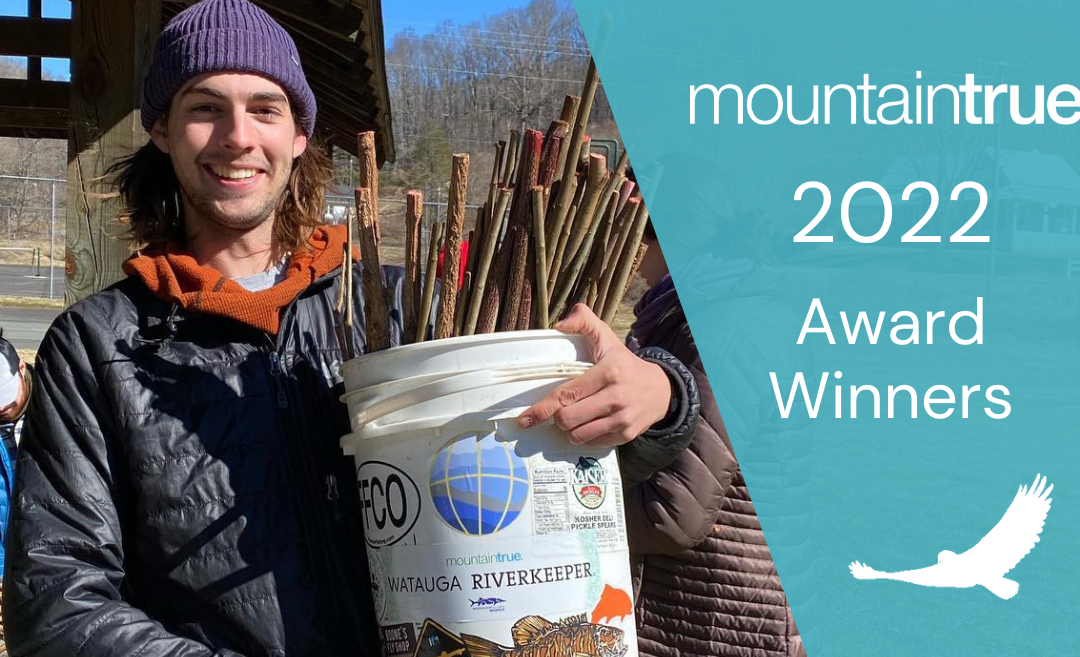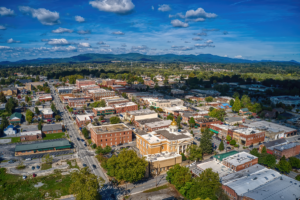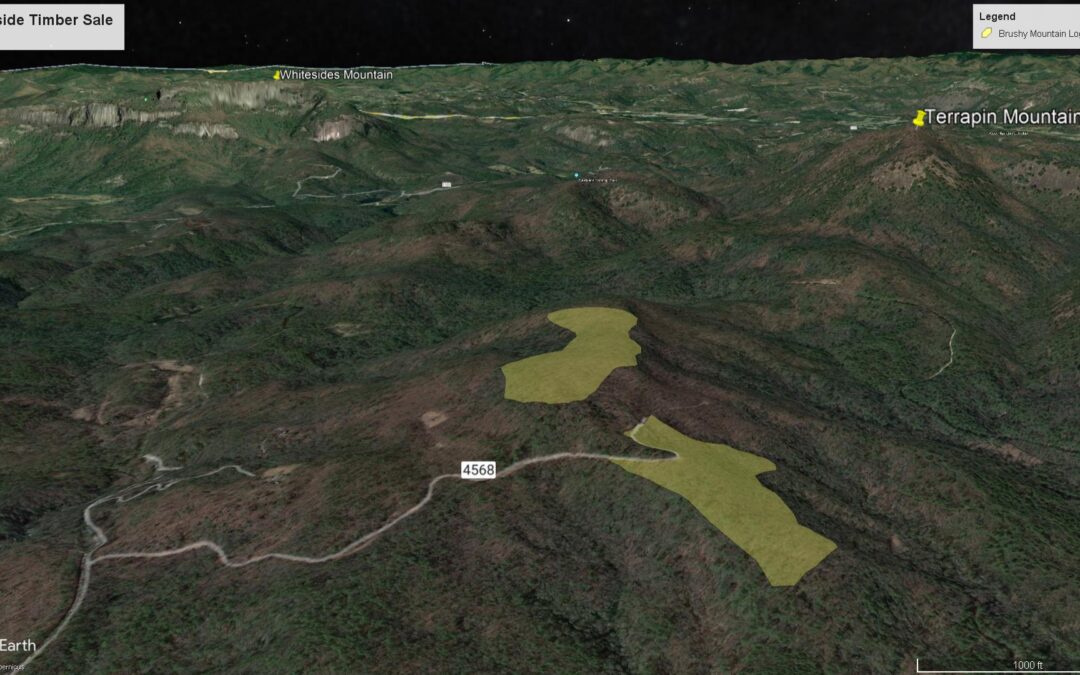No Results Found
The page you requested could not be found. Try refining your search, or use the navigation above to locate the post.

Every year, MountainTrue recognizes five individuals from across the Southern Blue Ridge as our regional Volunteer of the Year and Esther Cunningham award winners. We look forward to celebrating these exceptional MountainTrue volunteers at our 40th Anniversary Celebration on October 12, 2022:
Hayden (pictured above) works at a local fly shop in Boone, NC. He’s an excellent angler and guide, and he often goes above and beyond to take care of his local waterways. His practice of giving back and leaving our rivers and woods better than he finds them permeates his friendships, work relationships, and his career. He’s a consistent water quality volunteer with our High Country water quality team and his impact is being passed on to those fortunate enough to spend time with him on the trail or in the river. Thanks so much for all you do, Hayden!
Jim Clark has been helping us clean up the French Broad River for years. He’s been a Swim Guide volunteer for nearly ten years and has been a part of our microplastics sampling team from the very beginning. The data he’s gathered at Pearson Bridge has helped to get the new Real-Time E. coli Estimator (created in partnership with NCDEQ) up and running. He’s gone out of his way to keep trash out of the river, including lugging dozens of heavy, muddy tires out of its reach. Thanks for all your hard work to make the river a better place, Jim!
This year, Stacey has volunteered with both of our Adopt-A-Stream water quality monitoring programs (water chemistry and E. coli) and our Swim Guide program. Stacey’s unwavering dedication to our weekly Swim Guide sampling program helped many folks from across the Western Region know where it was safe to swim this summer! When her sampling site failed for the first time in August, she returned to resample and continued to check and photograph the beach for several additional days to monitor the source of the pollution: goose droppings! Stacey has offered to help with festival tabling events and is interested in doing anything needed to help with MountainTrue’s mission, particularly in the water quality program area. She’s a true super volunteer!
When Don learned about high bacteria levels in his community’s local waterways, he sprung to action and rallied the support of his fellow Rotarians. With his leadership, dozens of volunteers collected hundreds of water samples from streams in and around Hendersonville over the last several years. The data generated from his efforts helped us isolate the sources of bacteria pollution and direct our advocacy resources in the right direction to make meaningful change for water quality and public health. Thank you so much for your leadership, Don!
This award is given each year in honor of one of our organization’s founders, Esther Cunningham. Esther bravely stood in the face of opposition, rallied her community to stand with her, and tirelessly fought to protect and defend the forests of Western North Carolina.
Grady and his wife, Kathleen, have been MountainTrue members since 2015. In that time, Grady has repeatedly stepped up to support MountainTrue and our region in a number of ways. Grady spent his career in the electric utility industry and has been a crucial resource to our energy-focused work, especially as we were working both in opposition to and in partnership with Duke Energy. Grady also served on the Henderson County Environmental Advisory Committee for several years, pushing the county to do more in terms of energy efficiency and renewable energy. Finally, and perhaps most importantly, Grady has served on MountainTrue’s board as our treasurer since 2019. He has acted more like a CFO than just a board member and has been enormously helpful as our budget and the complexity of our budgeting have grown. Grady also says yes to every request we make of him. He has been a thoughtful, conscientious, and diligent board member and treasurer, and we will miss him terribly when he rolls off the board at the end of this year. Because of his commitment and service to MountainTrue and his dedication to the environment, we are pleased to award him with the 2022 Esther Cunningham Award.

MountainTrue has partnered with the North Carolina Department of Environmental Quality (DEQ) and the Pigeon River Fund to create a new website that provides the public with real-time water quality estimates at Pearson Bridge on the French Broad River in Asheville, NC. The website combines existing technology and new mathematical modeling to estimate E. coli conditions in real time.
The modeling correlates water turbidity data provided by the U.S. Geological Survey with MountainTrue’s and DEQ’s E. coli data at Pearson Bridge. The French Broad River at Pearson Bridge is now one of the few places in the country to have a real-time E. coli estimate modeling system.
“The goals of the WNC Recreational Monitoring program are to empower and enhance the existing community of environmental organizations already monitoring water quality in WNC, while expanding the Department of Environmental Quality’s analytical abilities to shorten the turnaround time in E. coli analyses and further refine risks associated with elevated bacteria levels,” said Landon Davidson, Division of Water Resources Regional Manager. “Near real-time calculations of bacteria levels are valuable to users because rapid changes in river conditions can increase bacteria levels significantly.” For more information on the State’s WNC Recreational Water Quality program, visit the DEQ website.
French Broad Riverkeeper Hartwell Carson explains, “Summer is when river recreation is most popular, but it’s also when afternoon thunderstorms can roll in, cause significant runoff and drastically change water quality. This new technology helps eliminate that uncertainty by providing the public with real-time estimated bacteria levels so that they can make informed decisions about whether or how to spend time on the river.”
The French Broad River Watershed is one of the most popular water-based recreation areas in North Carolina. On any given warm day, the French Broad Watershed hosts thousands of tubers, swimmers, canoers, kayakers, anglers, and whitewater boaters. Recreators frequently wonder how clean the river is and if it’s safe to swim or paddle.
As part of its existing Swim Guide program, MountainTrue publishes E. coli data each week from May to September on the Swim Guide platform. MountainTrue utilizes the Environmental Protection Agency (EPA)-approved IDEXX method for collecting and analyzing water samples and compares the results against the safe standard for health determined by the EPA.
MountainTrue samples for E. coli because it’s the best indicator for the presence of microbes that pose threats to human health, such as Cryptosporidium, Giardia, Shigella, and norovirus. Heavy rains and storms often result in spikes in E. coli contamination, increasing the risk to human health. Contact with or consumption of contaminated water can cause gastrointestinal illness, skin, ear, respiratory, eye, neurologic, and wound infections. The most commonly reported symptoms are stomach cramps, diarrhea, nausea, vomiting, and low-grade fever.
While the Swim Guide program provides high-quality data, it suffers from a time lag, as E. coli samples take 18-24 hours to incubate. Water quality can vary significantly from week to week or even day to day. E. coli levels can change quickly with heavy rains, as stormwater triggers runoff from agriculture, sewer overflows, and failed septic systems. Swim Guide data taken from MountainTrue’s Pearson Bridge sampling site over the past month illustrates this problem. During a relatively dry period in June, E. coli levels at Pearson Bridge were well below the safe standard set by the U.S. Environmental Protection Agency (EPA). July’s heavy thunderstorms have caused E. coli levels at Pearson Bridge to spike significantly, including being over 25 times the EPA’s safe standard on July 13.
As our mountain region experiences increased high-intensity rain events as a symptom of climate change, developing a model that provides E. coli estimates to the public is important. The French Broad Riverkeeper says MountainTrue and DEQ want folks to have the resources they need to make more informed decisions about when and how to recreate the French Broad River. Now, this will be possible thanks to the real-time E. coli estimator model and the USGS Pearson Bridge turbidity gage data on which it is based.
These real-time estimates will also help the French Broad Riverkeeper and DEQ track sources of pollution as they continue working together to bring about a cleaner French Broad River. Visit frenchbroadwaterquality.com to view results in real time. Visit theswimguide.org/affiliates/

Geese, ducks, and swans may seem like a beautiful and natural part of a lakeside environment. You may enjoy them so much that you spend time feeding them or otherwise encouraging them to spend time on your property or in local parks. But overly large waterfowl populations can actually cause several problems for humans, water quality, and the birds themselves.
The Canada goose (Branta canadensis) has been present in North Carolina and Georgia historically in both migratory and residential populations. During the 1970s, the number of migratory geese coming to these states declined drastically. In response, in the early 1980s, state wildlife agencies introduced populations of a goose sub-species with weak migrating skills that quickly adapted to the suburban lakes and rivers of Georgia and North Carolina. This new population of resident geese exploded into 45,000 birds in Georgia and 100,000 birds in North Carolina, but generations later, they now have next to no migrating skills.
These large waterfowl populations leave a lot of droppings behind. According to Clear Choices Clean Water Indiana, a single Canada goose eats three to four pounds of grass and can create as much as two to three pounds of waste per day. These droppings are unsightly and odorous and can also make people sick. Goose feces carries similar bacterial strains to those present in mammal waste. Research has shown that goose poop contains a wide variety of pathogens capable of infecting humans. Parasites that cause gastrointestinal problems (particularly Cryptosporidium and Giardia) have also been found in waterfowl feces. And feces from geese, ducks, and swans commonly act as hosts for the parasite that causes swimmer’s itch.
A large population of migratory birds staying in Georgia and North Carolina during the winter does not drastically raise the bacterial count of a waterbody, thanks to the low seasonal temperatures. Intestinal strains of bacteria do not reproduce in cold or freezing temperatures. However, with a large geese population now residing in our lakes during the summer months, warmer water temperatures promote the growth of potentially harmful pathogens. Additionally, bird waste is high in phosphorus, a nutrient that increases algae growth in mountain lakes.
As a general rule, try to stay away from areas that are heavily contaminated with waterfowl droppings. If you come into contact with poo, wash your hands thoroughly before touching your face or other people. Thoroughly wash any shoes, feet, or clothes that come into contact with droppings as well. It is especially important that parents be vigilant about keeping children away from areas heavily covered in droppings.
Pictured above: Goose droppings on a public swimming beach in the Southern Blue Ridge Mountains.
How can you help?
Do not feed geese. Handouts of bread or other human food items have little nutritional value to geese, artificially satisfy their hunger, and make them reliant on nesting in parks and residential communities. Geese are herbivores, and green plants, including sedges and grasses, make up the bulk of their diet.
Make it difficult for geese to find an ideal nesting location. Lush green turf grass planted right up to the edges of our lakes, ponds, and rivers has created the perfect habitat for goose populations to explode. If you typically keep your grass cut short, try letting it grow tall around the edges of the shoreline or plant some native moisture-tolerant shrubs such as buttonbush, arrowwood viburnum, and others — this makes it more difficult for geese to walk from the water to the land and back, making your property less inhabitable. You can also identify places where you’ve seen geese nest previously and place an object there to prevent geese from nesting there in the future — this object must be large and heavy enough that the goose can’t move it.
Get (or adopt!) and train a dog to chase geese away from your property. Border collies and similar herding breeds are exceptionally capable of chasing unwanted waterfowl away. Training your pup(s) to chase away the geese in the mornings and evenings is one of the most effective methods to deter the birds from spending time on your property. The geese perceive the dogs to be predators and decide to find somewhere else to live.
Hunt residential goose communities. The Canada goose is not an endangered species and hunting is permitted. All of Western North Carolina is classified as a residential population hunting zone with three seasons in the fall and winter. Georgia has four seasons beginning in September. Visit wncwildlife.org or georgiawildlife.org to learn more.

Take action to oppose the weakening of land-use regulations and to save the Henderson County Comprehensive Plan.
The Henderson County Commission is backsliding on important land-use regulations, and that spells big trouble for the 2045 Comprehensive Plan and for our region’s ability to manage future growth and prevent sprawl.
In its July 20 meeting, Henderson County Commissioners went against the recommendations of their own planning board and voted to adopt extremely lax rules on residential storage units that would allow property owners to construct an unlimited number of storage units within five feet of neighboring properties.
More concerning is that Commissioner Michael Edney and Commission Chair Bill Lapsley have proposed a dangerous rollback to floodplain regulations. As reported by the Hendersonville Lightning, Edney has proposed allowing more industrial development in floodplains — an idea rejected in an 8-0 vote by its own appointed Planning Board. And Commission Chair Lapsley has suggested allowing for more residential and commercial development in floodplains as well. Building in floodplains increases the chances of flooding and puts homes, businesses, and people’s lives at risk. As climate change now causes 100-year floods much more frequently, Henderson County should be taking the opposite approach by increasing limits on floodplain construction.
MountainTrue has serious concerns about Commissioners’ willingness to circumvent and ignore the recommendations of the County’s Planning Board — an expert body appointed by the Commission to give input on these very issues. We are also concerned about Commissioner David Hill’s stated opposition to any countywide zoning (as quoted in the Hendersonville Lightning), especially as the County is preparing to release its draft Comprehensive Plan.
Done well, Henderson County’s 2045 Comprehensive plan will help our communities meet the challenges of climate change, a growing population, and increased development pressures on the natural environment. Done badly, it will have the opposite effect — leading to more sprawl, less preservation of farmland, and more of our forests being cut down to accommodate poorly-planned development.
As part of the Comprehensive Planning process, the county fielded a survey to gauge the priorities of Henderson County residents. They received more than 7,000 responses and found out that the public is overwhelmingly in favor of land-use protections, preservation and conservation.
Henderson County residents’ top 3 priorities for the 2045 Henderson County Comprehensive Plan:
But, these recent actions, coupled with the release of a poorly-designed draft Future Land Use Map, raise questions about whether Henderson County’s Commissioners care about the public’s priorities.

Henderson County’s new Comprehensive Plan will serve as the blueprint for growth and development over the next twenty years. Learn about how this plan will help determine how our communities grow and develop to meet the challenges of climate change, a growing population, and increased pressures on our built environment.
Chris Joyell, MountainTrue’s Healthy Communities Director, discusses how Henderson County can welcome far more population growth than the state anticipates without causing sprawl. Watch.

ASHEVILLE, NC — Today, the US Forest Service closed bidding on 98 acres of the Southside Timber Sale (pictured above), which aims to eventually log 300 acres of North Carolina’s Nantahala National Forest, including critical tracts of old-growth forests. To stop the logging of old-growth forest, MountainTrue is offering to pay the Forest Service to keep the 37 acres of trees in place and the Forest intact.
This offer would protect exceptional old-growth forests from unnecessary logging and ensure the Forest Service recoups its investments in this sale. In fact, the Forest Service would make more money by accepting payment from MountainTrue, which is offering to match any offers for the value of the timber. Leaving the forest in place would free the Forest Service from the expense of administering the sale and overseeing roadbuilding and logging activities.
While the Forest Service typically does not accept payment to keep forests intact, this extraordinary offer is an effort to stop an extraordinarily harmful sale.
“We are willing to pay the Forest Service in order to save this old-growth forest and the critical habitat that it provides for native species,” explains Josh Kelly. “Our bid is both the most environmentally responsible and profitable option for the Forest Service.”
The 37 acres targeted by the Southside Timber Sale on Brushy Mountain are incredibly important ecosystems. Old-growth forests are made of trees that have been standing for centuries and hold tremendous amounts of carbon. Cutting these trees releases that carbon – tons of it – into the atmosphere, where it will worsen the impacts of climate change. Keeping these remarkable tracts of forest in the ground is a key step to fighting the climate crisis.
These forests also provide habitat for what experts recently documented as one of the most important green salamander populations in the state. Cutting these forests threatens this already-imperiled species. In fact, Forest Service leaders have ignored concerns from the agency’s own scientists about the impact logging could have on this already-imperiled species.
The Forest Service acknowledges that 17 acres on Brushy Mountain are old-growth and knows about the presence of the critically imperiled Blue Ridge lineage of green salamanders at the site but still insists on cutting this forest. Logging these critical tracts of forest will threaten at-risk species, worsen the impacts of climate change, and do permanent damage to these important ecosystems. USFS leaders should instead preserve these forests for generations by allowing MountainTrue to purchase the carbon rights to the forests for sale at Brushy Mountain in Southside Timber Sale – or by scrapping this misguided project altogether.
Have questions? Email Josh at josh@mountaintrue.org.

Bob: “I’ve been involved since the Forest Service’s planning process officially started in 2013. Prior to this, I also attended the first meetings held by The Wilderness Society (I think in 2011) when it first began to pull together a partnership of stakeholders in anticipation of the start of the planning process.”
Callie: “I’ve been involved in this forest planning process almost since the beginning, first as Executive Director of the Hiwassee River Watershed Coalition and then in my current role as MountainTrue’s Western Regional Director. I helped organize the Nantahala Pisgah Forest Partnership in 2011. Our initial focus was on making the best Forest Plan ever, but what we’ve really created over the past decade is a ‘lasting voice for innovative management and public investment in the public forests of North Carolina’s mountains for the future.’“
Josh: “I’ve been involved with this Forest Plan revision for almost 10 years. MountainTrue was involved with the very first Forest Plan in 1987. We championed a petition to the Chief of the Forest Service that led to the 1987 Plan being remanded and the creation of the 1994 Amendment.”
Bob: “It’s an important continuation of the forest protection work I did for what was then the Western North Carolina Alliance (now MountainTrue) during the decade before Josh came aboard. As a botanist/forest ecologist, I’ve always felt it’s important to work to keep our mountain ecosystems as healthy and secure as possible, given the continuing challenges from development, fragmentation, poor forest management, and climate change. On a personal level, my heart is in these mountains!”
Callie: “Almost 20 years ago, I chose to make my home in Western North Carolina because of the amount of public land in these mountains. Nantahala National Forest is only eight miles from my house by car. It’s the view out my window — it’s my backyard!”
Josh: “The new Forest Plan will set the management direction for over one million acres of Pisgah and Nantahala National Forests for the next 20 years. These forests are incomparable in their ecological and social value. They support thousands of species — many of them found nowhere else, they nourish the hearts and souls of millions of people, and they’re a huge part of important traditions.”
Bob: “Because the Forest Plan has not become finalized (due to the ongoing objection process), I’m not quite sure yet. But, there’s currently a strong focus on timbering that people should know about. I do think it’s encouraging that we have a diversity of partner organizations in place who have stated their commitment to helping the Forest Service implement the Plan over the next two decades. Their collaboration will be essential in shaping good management out of whatever becomes the Final Plan.”
Callie: “While water quality and riparian protections are pretty strong, the Plan sets up the next 20 years to continue the tradition of making Nantahala the ‘working forest’ and Pisgah the ‘recreational forest.’ While timber harvest and recreation will of course continue to occur on both forests in a variety of locations, the emphasis for Nantahala is much more oriented toward timber harvest.”
Josh: “The Revised Plan puts too much emphasis on logging cove forests. Southern Blue Ridge Cove Forests are some of the most diverse temperate forests on the planet. They grow the biggest trees in our region, support diverse understories of wildflowers and medicinal plants, protect water quality, and have historically been over-exploited. The new Forest Plan should instead put more emphasis on thinning and burning the fire-adapted forests that respond positively to timber harvest and are suffering from a lack of fire.”
Bob: “My favorite conservation-related places are the old-growth forests in Nantahala’s Big Choga Creek area and Pisgah’s Daniel Ridge area. I’m also equally fond of the rare Southern Appalachian bogs in both national forests. My favorite recreation area is probably Pisgah’s Pilot Cove Loop (which is also a Natural Heritage Area), but it’s hard to pick out a single place!”
Callie: “Fires Creek. Hands down. With its crystal clear, cold waters, unique biodiversity, trout fishing, hiking, camping, horseback riding, picnicking, swimming, and hunting, Fires Creek offers something for everyone!”
Josh: “There are many great areas in Pisgah and Nantahala National Forests, but none are better to me than Santeetlah Creek in Graham County. It’s just an incredible landscape that inspires me every time I visit.”
We and our organizational partners had a great time at the Pisgah Party + Rally for the Forest, organized by I Heart Pisgah on August 1, 2022. Over 500 people attended and made clear that too much of Nantahala and Pisgah are being prioritized for logging. The Objection meetings hosted by the Forest Service from August 2-4 went well. The dialogue was high-quality and our team was well prepared — we made our case and the Forest Service should realize they need to make some changes to the new Forest Plan. We hope the Forest Service seriously reviews and implements the solutions included in the Nantahala-Pisgah Forest Partnership’s proposal. The Forest Service expects to respond to all objections and finalize the Forest Plan by late 2022. Click here to read our blog detailing our objections to the Draft Forest Plan.
The page you requested could not be found. Try refining your search, or use the navigation above to locate the post.